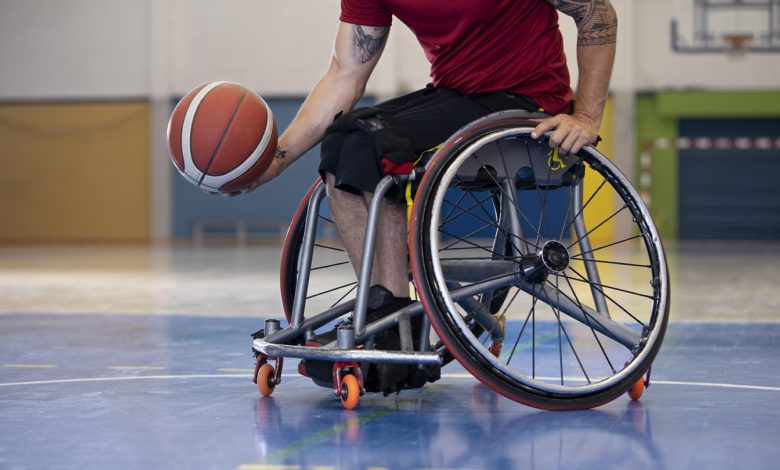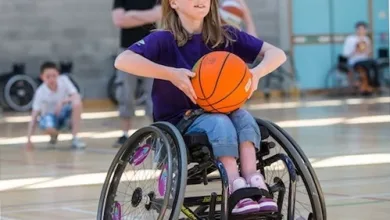Gearing Up for Greatness: A Guide to Sports Wheelchairs

Table of Contents
Gearing Up for Greatness: A Guide to Sports Wheelchairs
Imagine the feeling of wind whipping through your hair (or helmet!) as you race down the track. Or maybe you picture yourself soaring through the air on a wakeboard, the sun warm on your skin. These experiences aren’t out of reach for wheelchair users – the world of adaptive sports is bursting with possibilities!
But before you hit the court, field, or track, you’ll need the right equipment. That’s where sports wheelchairs come in. These specialized chairs are designed to empower athletes of all abilities to participate in their favorite sports. Unlike everyday wheelchairs, sports wheelchairs prioritize features like:
- Lightweight construction: For maximum speed and agility.
- Enhanced maneuverability: For quick turns and precise movements.
- Stability and support: To keep athletes safe and comfortable during competition.
So, are you ready to explore the different types of sports wheelchairs available? Let’s buckle up and take a ride!
Taking the Court by Storm: Wheelchairs for Classic Sports
Basketball Wheelchairs: Picture a fast-paced game of wheelchair basketball – players zipping around the court, dribbling with impressive skill. Their trusty steeds? Basketball wheelchairs! These chairs boast a high center of gravity for stability during collisions and tight turns. Small front wheels allow for quick maneuvering, while large rear wheels ensure speed.
Tennis Wheelchairs: Imagine yourself dominating the court with powerful serves and backhands. Tennis wheelchairs are lightweight and agile, with a low center of gravity for stability during strokes. They often have a unique outrigger wheel that prevents tipping during intense rallies.
Racing Towards Victory: Wheelchairs Built for Speed
Racing Wheelchairs: For athletes who crave the thrill of speed, racing wheelchairs are the ultimate companions. Imagine yourself feeling the rush of adrenaline as you zip down the track. These sleek machines are designed for maximum speed and efficiency. They’re incredibly lightweight and aerodynamic, with a reclined seating position to minimize wind resistance.
Handcycles: These three-wheeled bicycles are propelled by hand instead of feet. They’re a fantastic option for athletes with upper-body strength but limited lower-body mobility. Imagine the feeling of cruising down a scenic path, the wind in your face, enjoying the freedom of movement.
Beyond the Mainstream: Exploring Unique Sports Wheelchairs
The world of adaptive sports extends far beyond traditional games. Here are some fascinating, lesser-known sports wheelchairs:
- Rugby Wheelchairs: Imagine the intensity and physical demands of rugby but played from a seated position. Rugby wheelchairs are similar to basketball wheelchairs but even more robust and more rugged. They can withstand the physical challenges of this dynamic sport.
- Water Sports Wheelchairs: Do you dream of conquering the waves or paddling across a calm lake? Water sports wheelchairs are designed for use in the water, such as kayaking or canoeing. These chairs are made from lightweight, corrosion-resistant materials and often have flotation devices for added safety.
Going the Extra Mile: Specialized Sports Wheelchairs
For some sports, standard wheelchairs require specific adaptations to ensure optimal performance and safety. Let’s explore a few examples:
- Boccia Wheelchairs: This Paralympic sport is similar to bocce ball but played seated. Boccia wheelchairs resemble standard manual wheelchairs but often have a lowered seat to allow players to get closer to the court for more precise throws.
- Snow Skiing and Snowboarding Adaptations: Imagine carving down a snowy mountain slope with the wind in your hair. While not technically wheelchairs, there are specialized adaptations that allow people who use wheelchairs to participate in winter sports. These include sit-skis, which resemble regular skis but have a bucket seat, or snowboarding attachments that connect to a standard wheelchair frame.
The Future of Sports Wheelchairs: Innovation Never Stops
The world of adaptive sports is constantly evolving, with new technologies and equipment emerging all the time. Here’s a glimpse into what the future might hold:
- E-racing Wheelchairs: Imagine the thrill of high-speed racing on a specially designed track. E-racing wheelchairs are a game-changer, featuring electric motors and advanced controls for exhilarating racing experiences.
- Dance Wheelchairs: For athletes who love to express themselves through movement, dance wheelchairs offer a unique platform. These chairs prioritize agility and balance, often featuring a raised
There are many different types of sports wheelchairs, each designed for a specific sport or activity. Here are some of the most common types:
Basketball wheelchairs are strong and stable, with a high center of gravity to help players avoid tipping over during collisions. They also have small front wheels for quick maneuvering and large rear wheels for speed.
Basketball wheelchair
Tennis wheelchairs are lightweight and maneuverable, with a low center of gravity for stability during strokes. They often have a special outrigger wheel that helps to prevent tipping.
Tennis wheelchair
Racing wheelchairs are designed for maximum speed and efficiency. They are very lightweight and aerodynamic, with a reclined seating position to reduce wind resistance.
Racing wheelchair
Handcycles are three-wheeled bicycles that are propelled by hand instead of feet. They are a great option for people who have upper body strength but limited lower body mobility.
Handcycle
Rugby wheelchairs are similar to basketball wheelchairs, but they are even stronger and more rugged to withstand the physical demands of rugby.
Rugby wheelchair
Water sports wheelchairs are designed for use in the water, such as kayaking or canoeing. They are made from lightweight, corrosion-resistant materials and often have flotation devices to keep the user safe.
Water sports wheelchair
When choosing a sports wheelchair, it is important to consider the specific sport or activity that you will be using it for, as well as your own individual needs and abilities. There are also many different manufacturers of sports wheelchairs, so it is important to shop around to find one that is the right fit for you.
Boccia wheelchairs are similar to standard manual wheelchairs, but they often have a lowered seat to allow players to get closer to the court. Boccia is a Paralympic sport similar to bocce ball, but played seated.
Boccia wheelchair
Field hockey wheelchairs are specially designed for the fast-paced sport of field hockey. They are lightweight and maneuverable, with features like anti-tip bars for stability during sharp turns.
Field hockey wheelchair
Volleyball wheelchairs share some characteristics with basketball wheelchairs, but they may have a slightly lower center of gravity and different footrests to accommodate the specific movements required in volleyball.
Volleyball wheelchair
Foot cycling wheelchairs are a unique type of wheelchair that allows users to propel themselves with their feet. They have pedals attached to the front wheels, and some models even have gears for added efficiency.
Snow skiing and snowboarding adaptations While not technically wheelchairs, there are specialized adaptations that allow people who use wheelchairs to participate in these winter sports. These adaptations may include sit-skis, which are similar to regular skis but with a bucket seat, or snowboarding attachments that connect to a standard wheelchair frame.
Snowboarding adaptation for wheelchair
The world of adaptive sports is constantly evolving, with new technologies and equipment being developed all the time. This allows people of all abilities to participate in a wide variety of sports and activities. If you’re interested in getting involved in a particular sport, be sure to do some research to find out what type of equipment is available and what resources are available in your area.
Delving deeper into the world of sports wheelchairs, here are some lesser-known but equally exciting options:
Curling wheelchairs: Designed for the strategic sport of curling, these wheelchairs feature a rotating base that allows for precise maneuvering on the ice. They may also have special grips or handles to assist with pushing the curling stone.
Curling wheelchair
Rowing shells: While not technically wheelchairs, rowing shells can be adapted for people with lower body limitations. These adaptations can include specialized rowing seats and outrigger supports for stability.
Dance wheelchairs: Unlike traditional wheelchairs, dance wheelchairs prioritize agility and balance, often featuring a raised seat and a more flexible frame to allow for a wider range of movement.
Dance wheelchair
Water skiing and wakeboarding adaptations: Similar to snow sports, adaptations exist for water skiing and wakeboarding. These can include specialized water skis with supportive seating or modified wakeboards with secure harnesses.
E-racing wheelchairs: The world of motorsport isn’t out of reach either! E-racing wheelchairs are a relatively new development, featuring electric motors and advanced controls for exhilarating racing experiences.
E-racing wheelchair
Remember, this list isn’t exhaustive! As adaptive sports gain more popularity, we’re likely to see even more innovative and specialized wheelchairs emerge in the future.
Certainly! Here are some additional, more specific types of sports wheelchairs that cater to niche activities:
Table tennis wheelchairs: These wheelchairs prioritize maneuverability and stability for quick reactions and precise movements needed in table tennis. They might have a slightly lower center of gravity than standard wheelchairs.
Fencing wheelchairs: Designed for the fast-paced sport of fencing, these wheelchairs are lightweight and agile, often featuring anti-tip bars and specialized footrests for lunges and rapid maneuvering.
Goalball wheelchairs: Goalball is a Paralympic sport similar to soccer, but played blindfolded. Goalball wheelchairs are similar to standard manual wheelchairs but may have additional features like enhanced padding or a lower center of gravity for better balance during throws and blocks.
Horseback riding adaptations: While not wheelchairs themselves, there are adaptations available for horseback riding enthusiasts who use wheelchairs. These can include specialized saddles with additional support and leg straps for stability.
Rock climbing adaptations: Rock climbing is an activity that can be adapted for people who use wheelchairs. Climbing harnesses can be modified for use with wheelchairs, and climbing walls can have features like handholds positioned lower for increased accessibility.
It’s important to remember that many of these specialized wheelchairs may be custom-built or require specific modifications to suit the individual athlete’s needs and the demands of the particular sport.



